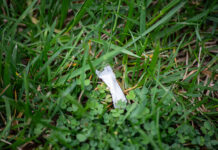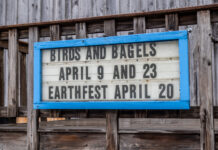The lights dim in the ATS Auditorium, and the screen lights up to show a lone dancer in a yellow tutu, purple tights and bulky, worn-out boots to match. Moving effortlessly alongside a rundown brick building, the dancer performs her routine delicately and with grace, all while the cameraman moves the camera in sync with her very movements.
This short Russian film, titled “Lola,” was one of 10 different short dance films screened at the Third Coast Dance Film Festival at 12:30 p.m. Thursday, as part of the Kaleidoscope Arts Festival.
According to assistant professor of theater and Kaleidoscope director Colleen Reilly, the film festival was part of a series of “Uncommon Hour” events to fit the daily schedules of the university.
In its third year, the film festival’s central theme for this year focused on films that told different stories with different film techniques and dances that incorporated various artistic styles.
“These [films] feature dynamic choreography and innovative filmmaking, and we thought those were nice fits with the already existing departments on campus,” Reilly said.
Jennifer Keller, professor of dance and assistant to the Dean of the College of Humanities, Fine and Performing Arts, said the film festival was started by SRU dance graduate and festival curator Rosie Trump.
“She called me back in September and said, ‘Would SRU want to partner with us and screen this at your university?’” Keller said. “So we jumped on that, and were really excited to feature that as part of Kaleidoscope.”
Keller said the films varied in meaning and story, but they all were a part of a newer genre of film.
“The genre that [the films] all belong to is called ‘Dance for the Camera,’” Keller said. “’Dance for the Camera’ is a relatively new field that combines film directors, dance choreographers, videographers [and] storyboard writers into creating these short films. The camera moves, and the camera is as much a partner or a participant on the screen as the subjects themselves.”
In this particular genre, Keller said the camera is sometimes fixated from a point-of-view perspective of the dancer’s body. This approach for using different camera angles is employed as a means to capture movements on camera, while actually moving with the dancer.
When describing the sort of preparations required for such films, Keller used one of the short films in this year’s film festival’s lineup as an example.
“There is one piece called ‘Stranger Dances,’ and in this particular selection, a film student went up to strangers on the street and asked them to dance, and then out of the very improvisational footage, edited together this film,” she said. “So that is someone that used just one camera and one person on the street, not on any fancy kind of set, that put their film together.”
Reilly said faculty from the Department of Dance brought this series and style of films to her attention for this year’s film festival.
“I certainly know that Jennifer Keller has been working in this area, between dance and film technology, so this is supporting that curriculum, but also just raising awareness about the possibilities of this kind of art form,” she said.
Though the series of films was a collaboration involving Rice University in Houston, TX, Keller said SRU dance students work on similar projects as part of their curriculum.
“We currently have students that are developing ‘Dance for the Camera’ films, and right now we feature those in our senior dance concert,” she said. “This year, we had seven films that were created by students and were screened.”
Keller said that she feels hopeful for her students’ projects gaining attention from other areas.
“We would love to have our students submit their work to a national festival like this,” she said. “That would be wonderful.”







